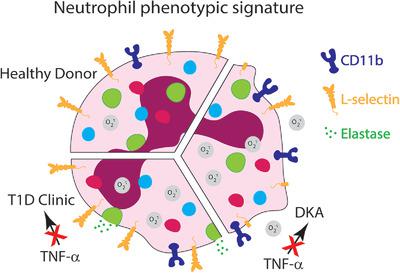当前位置:
X-MOL 学术
›
J. Leukoc. Biol.
›
论文详情
Our official English website, www.x-mol.net, welcomes your
feedback! (Note: you will need to create a separate account there.)
Novel neutrophil phenotypic signature in pediatric patients with type 1 diabetes and diabetic ketoacidosis
Journal of Leukocyte Biology ( IF 3.6 ) Pub Date : 2021-08-03 , DOI: 10.1002/jlb.3a1220-826r Blake E Nichols 1 , Jessica S Hook 1 , Kayson Weng 1 , Chul Ahn 2 , Jessica G Moreland 1, 3
Journal of Leukocyte Biology ( IF 3.6 ) Pub Date : 2021-08-03 , DOI: 10.1002/jlb.3a1220-826r Blake E Nichols 1 , Jessica S Hook 1 , Kayson Weng 1 , Chul Ahn 2 , Jessica G Moreland 1, 3
Affiliation

|
Type 1 diabetes (T1D) is a chronic inflammatory condition sometimes complicated by acute diabetic ketoacidosis (DKA). A subset of patients with T1D develop DKA independent of known risk factors. This study tested the hypothesis that circulating polymorphonuclear leukocytes (PMN) from children with T1D and DKA would exhibit a primed phenotype and that the signature would be unique in patients predisposed to have DKA. Using a prospective cohort study design, neutrophil phenotype was assessed in 30 patients with T1D seen in endocrinology clinic for routine care, 30 patients with acute DKA, and 36 healthy donors. Circulating PMN from patients with DKA display a primed phenotype with increased basal cell-surface CD11b, L-selectin shedding, and enhanced fMLF-elicited reactive oxygen species (ROS) production. Moreover, PMN from T1D patients both with and without DKA lack the capacity to be further primed by incubation with TNF-α, a classic priming stimulus. Primed PMN phenotypic signatures demonstrated are independent of hemoglobin A1c, the premier biological marker for DKA risk, and are consistent with a hyperinflammatory state. A single nucleotide polymorphism in TLR-1 (1805G>T), known to be associated with a hyperinflammatory PMN phenotype, correlated with DKA. This study elucidated a novel phenotypic signature in circulating PMN from children with T1D with and without DKA, and suggests the possibility of a previously unrecognized PMN phenotype with potential clinical implications. Immunophenotype and genotype may be applicable as biomarkers for DKA risk stratification in patients with T1D.
中文翻译:

1 型糖尿病和糖尿病酮症酸中毒儿科患者的新中性粒细胞表型特征
1 型糖尿病 (T1D) 是一种慢性炎症性疾病,有时会并发急性糖尿病酮症酸中毒 (DKA)。一部分 T1D 患者发生 DKA,与已知风险因素无关。这项研究验证了这样的假设,即来自 T1D 和 DKA 的儿童的循环多形核白细胞 (PMN) 将表现出引发表型,并且该特征在易患 DKA 的患者中是独特的。使用前瞻性队列研究设计,评估了 30 名在内分泌诊所接受常规护理的 T1D 患者、30 名急性 DKA 患者和 36 名健康供体的中性粒细胞表型。DKA 患者的循环 PMN 表现出基底细胞表面 CD11b、L增加的引发表型-选择素脱落和增强的 fMLF 引发的活性氧 (ROS) 产生。此外,患有和未患有 DKA 的 T1D 患者的 PMN 都缺乏通过与经典的启动刺激物 TNF-α 孵育来进一步启动的能力。所证明的初始 PMN 表型特征与血红蛋白 A1c(DKA 风险的主要生物标志物)无关,并且与高炎症状态一致。TLR-1 中的单核苷酸多态性 (1805G>T),已知与高炎症性 PMN 表型相关,与 DKA 相关。本研究阐明了患有和不患有 DKA 的 T1D 儿童循环 PMN 中的新表型特征,并表明以前未被识别的 PMN 表型具有潜在临床意义的可能性。
更新日期:2021-08-03
中文翻译:

1 型糖尿病和糖尿病酮症酸中毒儿科患者的新中性粒细胞表型特征
1 型糖尿病 (T1D) 是一种慢性炎症性疾病,有时会并发急性糖尿病酮症酸中毒 (DKA)。一部分 T1D 患者发生 DKA,与已知风险因素无关。这项研究验证了这样的假设,即来自 T1D 和 DKA 的儿童的循环多形核白细胞 (PMN) 将表现出引发表型,并且该特征在易患 DKA 的患者中是独特的。使用前瞻性队列研究设计,评估了 30 名在内分泌诊所接受常规护理的 T1D 患者、30 名急性 DKA 患者和 36 名健康供体的中性粒细胞表型。DKA 患者的循环 PMN 表现出基底细胞表面 CD11b、L增加的引发表型-选择素脱落和增强的 fMLF 引发的活性氧 (ROS) 产生。此外,患有和未患有 DKA 的 T1D 患者的 PMN 都缺乏通过与经典的启动刺激物 TNF-α 孵育来进一步启动的能力。所证明的初始 PMN 表型特征与血红蛋白 A1c(DKA 风险的主要生物标志物)无关,并且与高炎症状态一致。TLR-1 中的单核苷酸多态性 (1805G>T),已知与高炎症性 PMN 表型相关,与 DKA 相关。本研究阐明了患有和不患有 DKA 的 T1D 儿童循环 PMN 中的新表型特征,并表明以前未被识别的 PMN 表型具有潜在临床意义的可能性。











































 京公网安备 11010802027423号
京公网安备 11010802027423号